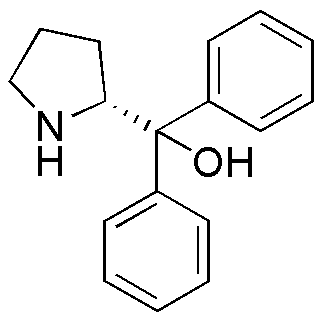(R)-(+)-Diphenyl-2-pyrrolidinemethanol is widely utilized in research focused on
- Pharmaceutical Development: This compound serves as a key intermediate in the synthesis of various pharmaceuticals, particularly in the development of drugs targeting neurological disorders.
- Catalysis: It is employed as a chiral catalyst in asymmetric synthesis, helping to produce enantiomerically pure compounds, which are crucial in the production of many active pharmaceutical ingredients.
- Material Science: The compound finds applications in creating advanced materials, such as polymers and composites, enhancing their mechanical properties and thermal stability.
- Research in Organic Chemistry: It is often used in academic and industrial laboratories for studying reaction mechanisms and developing new synthetic methodologies.
- Biochemical Applications: The compound can act as a ligand in biochemical assays, aiding in the study of enzyme activities and interactions in various biological systems.
General Information
Properties
Safety and Regulations
Applications
(R)-(+)-Diphenyl-2-pyrrolidinemethanol is widely utilized in research focused on
- Pharmaceutical Development: This compound serves as a key intermediate in the synthesis of various pharmaceuticals, particularly in the development of drugs targeting neurological disorders.
- Catalysis: It is employed as a chiral catalyst in asymmetric synthesis, helping to produce enantiomerically pure compounds, which are crucial in the production of many active pharmaceutical ingredients.
- Material Science: The compound finds applications in creating advanced materials, such as polymers and composites, enhancing their mechanical properties and thermal stability.
- Research in Organic Chemistry: It is often used in academic and industrial laboratories for studying reaction mechanisms and developing new synthetic methodologies.
- Biochemical Applications: The compound can act as a ligand in biochemical assays, aiding in the study of enzyme activities and interactions in various biological systems.
Documents
Safety Data Sheets (SDS)
The SDS provides comprehensive safety information on handling, storage, and disposal of the product.
Product Specification (PS)
The PS provides a comprehensive breakdown of the product’s properties, including chemical composition, physical state, purity, and storage requirements. It also details acceptable quality ranges and the product's intended applications.
Certificates of Analysis (COA)
Search for Certificates of Analysis (COA) by entering the products Lot Number. Lot and Batch Numbers can be found on a product’s label following the words ‘Lot’ or ‘Batch’.
*Catalog Number
*Lot Number
Certificates Of Origin (COO)
This COO confirms the country where the product was manufactured, and also details the materials and components used in it and whether it is derived from natural, synthetic, or other specific sources. This certificate may be required for customs, trade, and regulatory compliance.
*Catalog Number
*Lot Number
Safety Data Sheets (SDS)
The SDS provides comprehensive safety information on handling, storage, and disposal of the product.
DownloadProduct Specification (PS)
The PS provides a comprehensive breakdown of the product’s properties, including chemical composition, physical state, purity, and storage requirements. It also details acceptable quality ranges and the product's intended applications.
DownloadCertificates of Analysis (COA)
Search for Certificates of Analysis (COA) by entering the products Lot Number. Lot and Batch Numbers can be found on a product’s label following the words ‘Lot’ or ‘Batch’.
*Catalog Number
*Lot Number
Certificates Of Origin (COO)
This COO confirms the country where the product was manufactured, and also details the materials and components used in it and whether it is derived from natural, synthetic, or other specific sources. This certificate may be required for customs, trade, and regulatory compliance.


